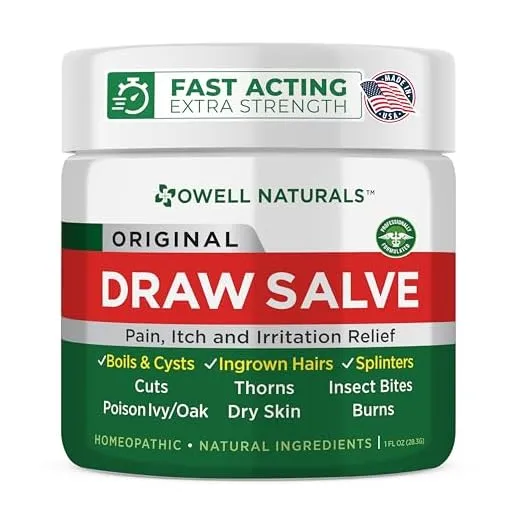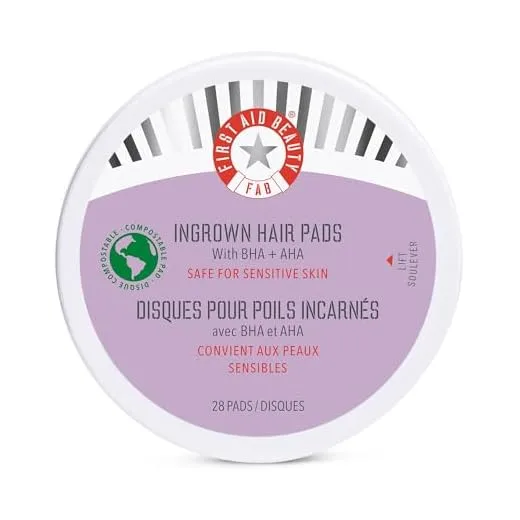This step-by-step guide is designed to assist you in recognizing and avoiding ingrown hairs with care and compassion. By adhering to the outlined steps, you can effectively manage this prevalent skin concern and nurture your skin’s well-being.
Top Solutions for Ingrown Hair Relief



Understand Ingrown Hairs
Understanding Ingrown Hairs
Learn about what ingrown hairs are, how they form, and why they can be problematic for your skin. Ingrown hairs occur when a hair curls back or grows sideways into the skin instead of rising up from it. This often leads to redness, irritation, and even infection. To effectively prevent ingrown hairs, start by understanding the root cause of the issue.
To prevent ingrown hairs:
- Exfoliate regularly: Gently exfoliate your skin to remove dead cells and allow hair to grow freely.
- Use a sharp razor: Always shave with a sharp razor in the direction of hair growth to avoid hair breakage.
- Avoid tight clothing: Tight clothing can cause friction, leading to ingrown hairs.
- Moisturize daily: Keep your skin moisturized to prevent dryness, which can contribute to ingrown hairs.By understanding how ingrown hairs form and taking preventive measures, you can maintain smoother, healthier skin.
Exfoliate Regularly
Exfoliate Regularly to Prevent Ingrown Hairs
Exfoliation helps remove dead skin cells that could clog hair follicles and lead to ingrown hairs. To keep your skin clear and avoid ingrown hairs, follow these steps:
- Select a gentle exfoliator: Choose a scrub or chemical exfoliant suitable for your skin type.
- Incorporate exfoliation into your routine: Aim to exfoliate 2-3 times a week, but adjust based on how your skin responds.
- Focus on areas prone to ingrown hairs: Concentrate on exfoliating areas where you commonly experience ingrown hairs.
- Follow up with moisturizer: After exfoliating, apply a moisturizer to keep your skin hydrated and healthy.
- Be consistent: Regular exfoliation can help prevent ingrown hairs and maintain smooth skin.
Use Proper Shaving Techniques
- Use Sharp, Clean Razors: Always ensure you have a sharp and clean razor before shaving. Dull blades can tug at the hair follicles, causing irritation and ingrown hairs. Regularly replace your razor blades to maintain a sharp edge for a smooth shave.
- Shave in the Direction of Hair Growth: To prevent skin irritation and ingrown hairs, shave in the direction that your hair grows. Shaving against the grain can lead to razor burn and ingrown hairs. Follow the natural direction of your hair growth to achieve a closer shave without irritation.
- Avoid Shaving Too Closely: Resist the urge to shave too closely to the skin. Shaving too closely increases the risk of hairs curling back into the skin, resulting in painful ingrown hairs. Leave a small buffer between the razor and your skin to reduce the likelihood of ingrown hairs.
Moisturize Your Skin
- Hydrate Your Skin to Prevent Dryness and Irritation: Apply a gentle, hydrating moisturizer to your skin regularly to keep it well-hydrated. This helps in preventing dryness and irritation that can lead to ingrown hairs. Choose a moisturizer that suits your skin type and apply it generously after showering or washing your face.
- Consistent Moisturizing Routine: Make moisturizing a part of your daily routine. Ensure that you apply the moisturizer to all areas prone to ingrown hairs, such as the legs, underarms, and bikini area. Remember to be consistent with this routine to maintain your skin’s hydration levels and reduce the risk of ingrown hairs.
Avoid Tight Clothing
Avoid Tight Clothing
Choose loose-fitting attire to prevent skin irritation and ingrown hairs caused by tight clothing rubbing against the skin and hair follicles. When garments are too tight, they create friction that can lead to discomfort and skin issues. Opt for clothing with a relaxed fit to minimize the chances of irritation and promote better skin health. Remember to prioritize comfort and avoid excessively tight clothing to maintain healthy skin and hair.
Seek Professional Help if Needed
- Consult a dermatologist: If you notice persistent ingrown hairs or experience infections as a result, it is crucial to seek advice from a dermatologist. For example, if you have ingrown hairs that keep returning despite your best efforts to prevent them, a dermatologist can provide specialized treatment options to help alleviate the issue. Additionally, if an ingrown hair becomes infected, resulting in redness, pain, or pus-filled bumps, it is imperative to consult a dermatologist promptly to prevent further complications.
- Consider professional treatment: In severe cases of ingrown hairs or infections, professional intervention may be necessary. For instance, a dermatologist can perform procedures such as laser hair removal or chemical exfoliation to help prevent ingrown hairs from occurring. By seeking professional help, you can address the root cause of the issue and receive targeted treatments that can effectively manage and prevent ingrown hairs and related infections.
Preventing Future Ingrown Hairs
In conclusion, implementing these strategies can help you effectively identify and prevent ingrown hairs, leading to improved skin health and a smoother complexion in the long run. Be proactive in your skincare routine to enjoy the benefits of healthier skin.
Essential Supplies
Expert Hair Care Advice
Subheading: Step-by-step Guide for Effective Ingrown Hair Treatment
- Start by exfoliating the affected area to help release ingrown hairs
- Apply the ingrown hair treatment product directly onto the ingrown hair or affected area as per the product instructions
- Allow the treatment to sit on the skin for the recommended time before rinsing off
- Use the ingrown hair treatment regularly as directed to prevent future ingrown hairs
- Moisturize the skin after treatment to keep it hydrated and healthy
Treatment Solutions
Are there any particular skincare products that can help prevent ingrown hairs?
Yes, there are certain skincare products that can help prevent ingrown hairs. Exfoliating scrubs or chemical exfoliants containing ingredients like salicylic acid or glycolic acid can help to remove dead skin cells and unclog hair follicles, reducing the likelihood of ingrown hairs. Additionally, using a moisturizer to keep the skin hydrated and soft can also be beneficial in preventing ingrown hairs. It’s important to choose products that are suitable for your skin type and to patch test new products to avoid any adverse reactions.
Are there any home remedies for treating ingrown hairs?
Yes, there are several home remedies that can help treat ingrown hairs. Some common remedies include gently exfoliating the area with a soft-bristled brush or scrub, applying a warm compress to help reduce inflammation, and using tea tree oil or aloe vera to soothe the skin. It is important to avoid picking or squeezing the ingrown hair to prevent infection. If the ingrown hair persists or becomes infected, it is best to seek medical advice.
How long does it typically take for an ingrown hair to go away on its own?
Ingrown hairs can typically take 1-2 weeks to go away on their own. However, in some cases, they may persist for longer or become infected, requiring medical intervention.
What are the common causes of ingrown hairs?
Ingrown hairs are commonly caused by hair removal methods such as shaving, waxing, or plucking, which can cause the hair to grow back into the skin instead of out of the follicle. Tight clothing, improper skin exfoliation, and curly hair can also contribute to the development of ingrown hairs.
Do certain hair removal methods increase the risk of ingrown hairs?
Yes, certain hair removal methods can increase the risk of ingrown hairs. Methods such as shaving, waxing, and plucking can lead to ingrown hairs because they can cause the hair to grow back improperly, leading to it getting trapped beneath the skin. Proper exfoliation and moisturizing can help reduce the risk of ingrown hairs when using these hair removal methods.
Can ingrown hairs lead to infection?
Yes, ingrown hairs can lead to infection. When the hair grows back into the skin instead of outward, it can cause irritation, redness, and sometimes infection. This can happen when the hair follicle becomes inflamed and bacteria enter the skin through the small opening created by the ingrown hair. Proper care and treatment of ingrown hairs can help prevent infections.
What is the difference between an ingrown hair and an infected hair follicle?
An ingrown hair occurs when a hair curls back or grows sideways into the skin rather than growing out of the hair follicle opening. It can cause inflammation, redness, and sometimes a small bump. An infected hair follicle, on the other hand, happens when bacteria enters the hair follicle, leading to redness, swelling, tenderness, and possibly the formation of pus. So, the main difference is that an ingrown hair is the misdirection of hair growth, while an infected hair follicle involves a bacterial infection of the hair follicle.
How can ingrown hairs be prevented?
To prevent ingrown hairs, you can try the following methods:
- Exfoliate regularly to remove dead skin cells and prevent hair follicles from becoming clogged.
- Shave in the direction of hair growth to avoid hair curling back into the skin.
- Use a sharp, clean razor when shaving to reduce irritation.
- Avoid tight clothing that can rub against the skin and cause ingrown hairs.
- Moisturize the skin to keep it soft and hydrated, which can prevent hairs from getting trapped.
- Consider trying alternative hair removal methods like waxing or using depilatory creams.
- If you frequently experience ingrown hairs, consult a dermatologist for personalized advice and treatment options.
When should you seek medical treatment for ingrown hairs?
You should seek medical treatment for ingrown hairs if you experience severe pain, redness, swelling, pus or discharge, signs of infection (such as fever), or if the ingrown hair does not improve with home treatment. Additionally, if you have recurring ingrown hairs or if they are causing significant discomfort or interfering with your daily activities, it is advisable to consult a healthcare professional for assessment and treatment.
Can ingrown hairs occur on any part of the body?
Yes, ingrown hairs can occur on any part of the body where hair grows. They are most commonly found in areas where hair is frequently shaved or waxed, such as the face, neck, armpits, legs, and pubic area. However, they can also occur in other areas where hair grows, such as the chest, back, and arms.



Leave a Reply